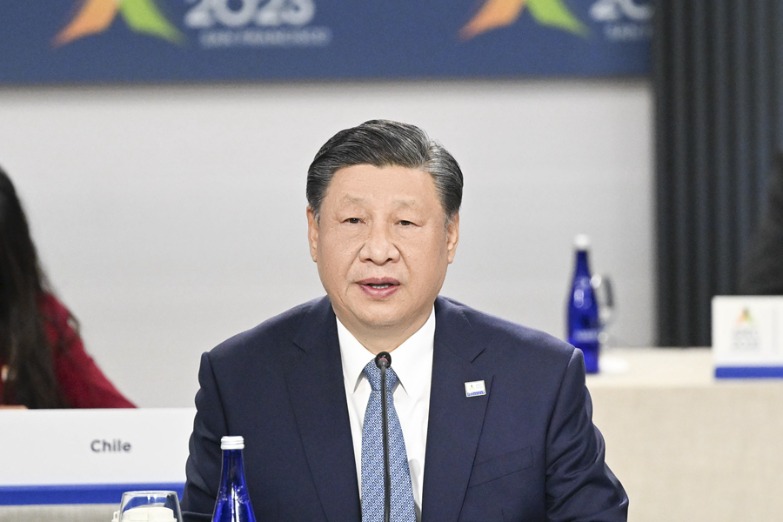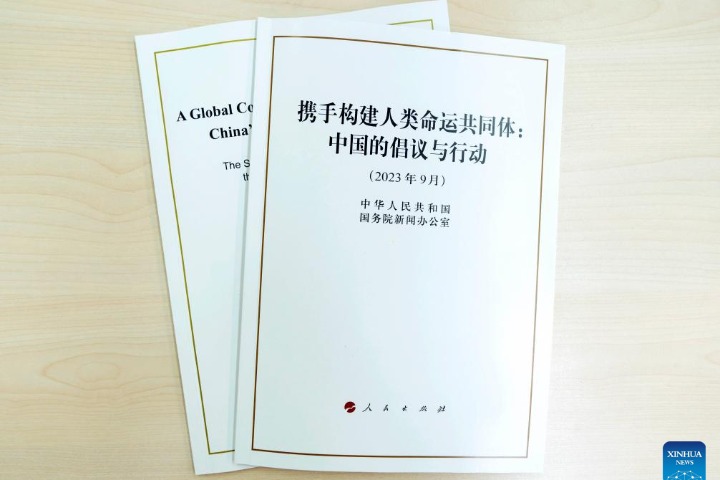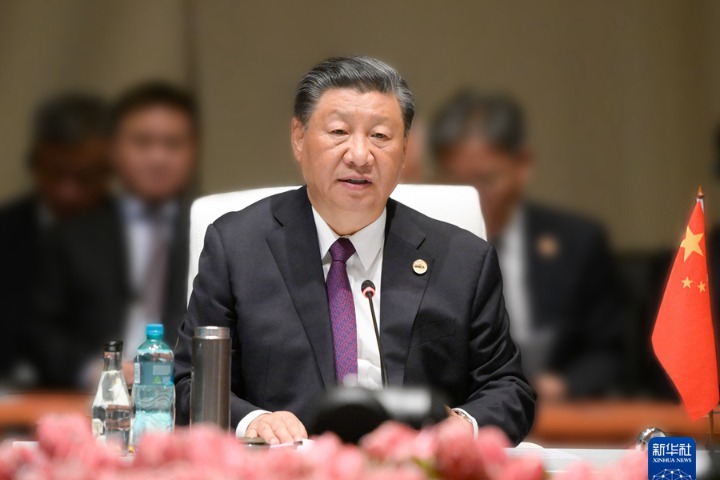西藏和平解放与繁荣发展(双语全文)
新华网 2021-05-21 16:00

八、生态安全屏障日益坚实
VIII. Solid Environmental Safety Barriers
青藏高原是“世界屋脊”“亚洲水塔”,西藏是中国重要的生态安全屏障。国家高度重视西藏生态文明建设,持续推进制度创新、筑牢科技文化支撑、加大生态建设投入,推动构建人与自然生命共同体。目前,西藏生态系统整体稳定,环境质量持续向好,绿色发展格局初步形成,人民生态环境权益不断提升,“绿水青山就是金山银山、冰天雪地也是金山银山”的理念深入人心,西藏成为世界上生态环境最好的地区之一。
The Qinghai-Tibet Plateau is known as “the roof of the world” and “the water tower of Asia.” Tibet is an important guarantor of China's environmental security. The Chinese government attaches great importance to eco-environmental protection in Tibet. It has made constant efforts to improve institutions, provide strong scientific and cultural support, and increase investment in this field, with the goal of building a community of life for humanity and nature.
Tibet's ecosystems are now generally stable. Environmental quality is improving, a green development model is in place, and eco-environmental rights and interests are more secure. “Clear waters and green mountains are invaluable assets, so is snow-covered land” – this concept is alive in people's hearts. Tibet has become one of the regions with the best eco-environment in the world.
——生态文明建设统筹推进
– Making coordinated progress in improving the eco-environment
和平解放初期,中国科学院就派出专家学者对西藏生态、地质气象进行综合考察。1973年和2017年国家先后开展两次青藏高原综合科学考察。2012年以来,出台《关于全面加强生态环境保护 坚决打好污染防治攻坚战的实施意见》《关于建设美丽西藏的意见》《关于创建国家生态文明建设示范区 加快建设美丽西藏的实施意见》《西藏自治区国家生态文明高地建设条例》等,不断完善监测监察考核体系。截至2020年,西藏累计投入生态环境领域的资金达814亿元。统筹山水林田湖草系统治理,大力实施《西藏生态安全屏障保护与建设规划(2008-2030年)》和“两江四河”流域绿化项目。持续推进生态文明创建示范工作。拉萨市、山南市、林芝市、昌都市和阿里地区获国家生态文明建设示范市称号,巴宜区、亚东县和当雄县获国家生态文明建设示范县称号,隆子县获“绿水青山就是金山银山”实践创新基地称号。加强水土保持工作,加大水土流失综合治理力度,全面推进河湖长制,设立区、市、县、乡、村五级河湖长1.48万名,实现河湖“清四乱”常态化制度化。2020年,噶尔县因河湖长制工作成效明显,被国务院办公厅列入激励名单。
Shortly after liberation, the Chinese Academy of Sciences sent specialists to Tibet to survey the local ecology, geology and meteorology. The Chinese government organized two comprehensive scientific investigations on the Qinghai-Tibet Plateau, in 1973 and 2017.
Since 2012, a number of regulations have been released to improve the system for monitoring and assessing the local eco-environment. These include Opinions on Strengthening Eco-environmental Protection and Pollution Prevention and Control, Opinions on Building a Beautiful Tibet, Opinions on Building National Ecological Culture Demonstration Areas to Boost Efforts for Building a Beautiful Tibet, and Regulations on Developing Ecological Highlands in the Tibet Autonomous Region. By 2020, Tibet had invested a total of RMB81.4 billion in this field.
A holistic approach to conserving mountains, rivers, forests, farmlands, lakes, and grasslands has been adopted. The Plan for Protecting and Improving the Ecological Safety Barriers in Tibet (2008-2030) and the afforestation project in the watersheds of the Yarlung Zangbo River, Nujiang River, Lhasa River, Nianchu River, Yalong River, and Shiquan River have been implemented.
Work has been carried forward to build eco-environmental culture demonstration areas. Lhasa, Shannan, Nyingchi and Qamdo cities and Ngari Prefecture won national titles for their pioneering work, as did Bayi District of Nyingchi City, Yadong County and Damxung County. Lhunze County has become a base for practicing the concept that clear waters and green mountains are invaluable assets.
The efforts to conserve water and soil and control soil erosion have been increased. A river/lake responsibility system, where officials at different levels are assigned responsibility for the governance of specific rivers and lakes, has been rolled out, involving 14,800 officials at the regional, city, county, township and village levels. In addition, the cleanup campaign initiated in 2018 to regulate illegal riverside occupation, construction, mining and waste, has become a systematic and standard practice. Gar County was recognized for outstanding performance in this regard by the State Council General Office in 2020.
——生态环境保持良好
– Maintaining a good eco-environment
现有11个国家级自然保护区、4个国家级风景名胜区、3个国家地质公园、9个国家森林公园、22个国家湿地公园,自然保护地占全区国土面积的38.75%。建立1个防沙治沙综合示范区、5个沙化土地封禁保护区,封禁面积达到4.8万公顷。2004年至2014年荒漠化土地面积减少9.24万公顷,沙化土地面积减少10.07万公顷。2020年森林覆盖率达到12.31%,天然草原综合植被覆盖度提高到47%,湿地面积达到652.9万公顷。加强野生动物及其栖息地保护,黑颈鹤由不到3000只上升到8000多只,藏羚羊约30万只。在第二次陆生野生动物资源调查中发现白颊猕猴等新物种5个,东歌林莺等中国新纪录物种5个。第二次野生植物资源调查结果显示,国家一级保护野生植物巨柏稳步增加并得到有效保护。调查中发现桫椤、喜马拉雅红豆杉等21个物种的新分布点。主要江河湖泊水质整体良好,雅鲁藏布江、纳木错水质达到《地表水环境质量标准》Ⅱ类标准,珠穆朗玛峰下绒布河达到Ⅰ类标准。实现化肥农药使用量零增长,土壤处于自然本底状态。2020年PM10和PM2.5年均浓度较2015年分别降低28.1%和37.5%,西藏空气优良天数达到99.4%。
Tibet has 11 national nature reserves, 4 national scenic spots, 3 national geological parks, 9 national forest parks, and 22 national wetland parks. Protected natural areas make up almost 40 percent of the region's land area. Tibet has one comprehensive demonstration area for desertification control, and five closed-off protection zones of desertified land covering an area of 48,000 hectares. From 2004 to 2014, Tibet saw a fall of 92,400 hectares in desertification and a decline of 100,700 hectares in sandification. In 2020, the forest coverage reached 12.3 percent, the comprehensive vegetation coverage of natural grassland grew to 47 percent, and the wetland area totaled 6.53 million hectares.
Wild animals and their habitats are better protected. The population of black-necked cranes has increased from no more than 3,000 in the 1990s to more than 8,000, and the population of Tibetan antelopes is around 300,000. In the second survey of terrestrial wild animals, five new species including white-cheeked macaques were discovered, and another five species were found for the first time in China, including the Eastern Orphean Warbler. The second survey of wild plants showed that the number of giant cypress – under Class A national protection – has steadily increased and been effectively protected. The survey also found 21 species including Alsophila spinulosa and Taxus wallichiana Zuccarini in new sites.
The water quality of major rivers and lakes is generally good. Quality in both the Yarlung Zangbo River and Lake Namtso is up to Class II standard of the Environmental Quality Standards for Surface Water of China, and that of the Rongbuk River under Mount Qomolangma, Class I standard.
The use of chemical fertilizers and pesticides has been held stable in Tibet, bringing the soil to a natural state. In 2020, Tibet saw its average concentrations of PM10 and PM2.5 declining by 28.1 and 37.5 percent respectively compared with 2015, and its days of good air quality fell just short of 100 percent.
——绿色发展格局初步形成
– A green development model in place
西藏将建设成为国家清洁能源接续基地。截至2020年,清洁能源已达到发电装机容量的89.09%。2015年至2020年底,累计外送清洁电力65亿千瓦时,大量减少了二氧化碳排放。推进国家级循环经济试点,加快餐厨废弃物资源化利用。深入推进固体废物监管,县级以上城镇生活垃圾无害化处理率达到97.34%,医疗废物实现应收尽收、应处尽处。2016年至2020年,城市污水处理率从50.19%提高到96.28%。美丽乡村建设持续推进,相继实施薪柴替代、厕所革命、环境整治、乡村绿化等项目,逐步建立健全农村生活垃圾收运处置体系。建立起覆盖草原、森林、湿地、野生动物肇事等领域的生态保护补偿机制,2019年至2020年,累计安排生态护林员补助资金2.74亿元,支持选聘生态护林员7.82万名,安排森林生态效益补偿补助31.82亿元,生态环境权益得到保障。持续开展“爱粮节约”活动和“光盘行动”,城乡居民节约用水用电意识显著增强,新能源电动汽车数量快速增长,绿色生活正成为新时尚。
Tibet is working to develop itself into a national clean energy base. By 2020, clean energy had contributed 89.1 percent of the installed power-generating capacity in Tibet. From 2015 to the end of 2020, 6.5 billion kwh of clean energy-generated electricity was transmitted, which greatly reduced carbon dioxide emissions.
A pilot national circular economy program has been carried out in Tibet, and efforts have been made to increase the utilization of kitchen waste. Solid wastes have been brought under strict regulation. The rate of safe domestic bio-waste disposal at or above the county level has reached 97.3 percent, and all medical waste requiring collection and treatment is collected and treated properly. The rate of urban sewage disposal grew from 50.2 percent in 2016 to 96.3 percent in 2020.
The initiative to build a beautiful countryside has advanced. Projects have been carried out to replace firewood with clean energy, build sufficient clean and safe toilets, improve living environments, and create green rural areas. A sound system to collect, transport and dispose of rural domestic sewage has been put in place.
A mechanism has been established to provide recompense for eco-protection of grasslands, forests and wetlands, and for damage caused by wild animals. From 2019 to 2020, RMB274 million was allocated in subsidies for selecting and recruiting 78,200 forest rangers, and RMB3.18 billion was granted as compensation and subsidies for forest protection, better ensuring people's eco-environmental rights and interests.
Campaigns have continued to encourage food saving and oppose food waste. Both urban and rural residents are more aware of the need to save water and electricity. New energy electric vehicles have grown in number. Green living is becoming part of everyday life.
九、坚定维护国家统一和社会稳定
IX. Resolutely Safeguarding National Unity and Social Stability
国家统一和社会稳定是西藏各项事业发展的重要保障,是西藏各族人民幸福生活的坚实依托。长期以来,西方反华势力从未停止利用所谓“西藏问题”扰乱遏制中国,十四世达赖集团从未放弃过“西藏独立”的图谋,不断制造事端,危害西藏安定团结的大好局面。为了保障西藏各项事业的发展和人民的幸福生活,卓有成效地开展了维护社会和谐稳定的工作。
National unity and social stability are important guarantors of all the undertakings of Tibet, and a solid buttress ensuring a happy life for all ethnic groups in Tibet. Over the years, Western anti-China forces have used Tibet as a pretext to disrupt China and interfere with its development, and the 14th Dalai Lama and his supporters have continued to try to promote “Tibetan independence” by provoking incidents to jeopardize peace and stability in Tibet. The Chinese government has taken effective measures to maintain social stability and harmony in the region.
——西方反华势力图谋搞乱西藏遏制中国
– The Western anti-China forces' attempts to create disorder in Tibet to contain China
长期以来,西方反华势力不断插手干涉中国西藏事务,企图破坏西藏社会稳定。早在西藏和平解放之前,美国政府即与西藏地方亲帝分裂势力建立联系。20世纪50年代中期,美国中央情报局在科罗拉多州训练从事暴力活动的“藏独”分子。西藏武装叛乱期间,美国中央情报局不仅派特工帮助十四世达赖逃亡,而且还空投大量武器装备,帮助重建叛乱武装。“四水六岗”则由美国中央情报局提供武器装备、教官,并直接指挥。20世纪80年代以来,在西藏发生的历次骚乱都有西方某些势力的插手。近年来,西方反华势力对西藏的干涉更是变本加厉。美国先后炮制了《2002年西藏政策法》《2018年对等进入西藏旅行法》《2020年西藏政策及支持法》等多部法案,图谋以所谓“西藏问题”干涉中国内政。
Over the years, Western anti-China forces have continued to interfere in China's Tibetan affairs in an attempt to sabotage its social stability. Prior to liberation, the US government had already established contacts with pro-imperialist separatists in Tibet. In the mid-1950s, the CIA helped to train Tibetan separatists in Colorado to carry out violent activities. During the armed rebellion in Tibet in 1959, the CIA helped the 14th Dalai Lama flee and airdropped a large quantity of weaponry to support rebel forces. The CIA was also in direct command of a rebel organization named “Four Rivers and Six Ranges”,[ This refers to the four main rivers and six mountain ranges in Tibet and the Tibetan-inhabited areas of Sichuan Province in southwestern China. – Tr.] providing it with weapons and training instructors.[ The CIA's Secret War in Tibet [Kenneth Conboy and James Morrison, University Press of Kansas: 2002] reveals how America's Central Intelligence Agency encouraged and eventually controlled Tibet's revolt against China. – Ed.]
Since the 1980s, Western forces have played an active role in all the outbreaks of unrest that have taken place in Tibet. In recent years, Western anti-China forces have intensified such efforts. Using the “Tibetan issue” as the excuse, the US government has enacted the Tibetan Policy Act of 2002, the Reciprocal Access to Tibet Act of 2018, and the Tibetan Policy and Support Act of 2020, to interfere in China's domestic affairs.
——十四世达赖集团阴谋从事分裂祖国活动
– The 14th Dalai group and their attempts to divide China
1959年,西藏反动上层发动全面武装叛乱、失败逃往印度后,公开主张以暴力手段实现“西藏独立”。随后,在美国支持下重组“四水六岗”,在尼泊尔木斯塘建立武装基地,长期在中尼边境进行骚扰活动。1962年,在外部势力支持下,组建以流亡藏人为主的“印藏边境特种部队”,不断袭扰中国边防军队和边境地区的平民。
In 1959, after the failure of their armed rebellion, the reactionaries of Tibet's ruling class fled to India. They subsequently began to campaign for “Tibetan independence” by force. Later, with the support of the US, they reorganized the “Four Rivers and Six Ranges” rebel organization, and set up a military base in Mustang, a county in Nepal, to engage in long-term attacks across the China-Nepal borders. In 1962, with support from external powers, they built a para-commando force composed of mainly Tibetan exiles to harass Chinese border troops and civilians along the China-India border.
20世纪70年代末以来,国际形势发生深刻变化,十四世达赖集团迫于形势压力,开始变换策略,一方面连续制造骚乱暴力事件向中央政府施压,1987年、1988年、1989年多次策划煽动暴力事件,2008年策划实施拉萨“3·14”打砸抢烧暴力事件,并在北京奥运会筹办期间在国际上制造一系列干扰破坏活动,引起国际社会极大愤慨。2011年以来,十四世达赖集团煽动蛊惑境内藏族僧俗信众自焚,并在网上发布《自焚指导书》,造成一段时间中国部分地区接连发生自焚事件。另一方面宣扬“非暴力”,提出所谓“中间道路”欺骗世人,1987年在美国国会人权核心小组会议提出“西藏和平五点计划”,1988年在法国斯特拉斯堡提出解决所谓“西藏问题”的“七点新建议”,2008年提出《为全体藏人获得真正自治的备忘录》。
From the late 1970s, under pressure from significant shifts in the international landscape, the 14th Dalai Lama and his supporters began to alter their tactics.
On the one hand, they continued to provoke incidents of violence to keep up pressure on the central government. For example, in 1987, 1988 and 1989 they planned and instigated multiple violent incidents. In 2008, they planned and executed violent riots in Lhasa on March 14 and launched a number of international incidents designed to sabotage the preparations for the Beijing Olympic Games. Since 2011, the 14th Dalai Lama and his supporters have incited Tibetan lamas and lay followers inside China to engage in acts of self-immolation, and released a Self-Immolation Guide on the internet, giving rise to a surge of self-immolation incidents in some parts of China.
On the other hand, they proclaimed a commitment to “non-violence” and the “middle way”. At the Congressional Human Rights Caucus in 1987 in Washington DC, the 14th Dalai Lama proposed a Five-Point Peace Plan and in 1988, in Strasbourg in France, he put forward the Strasbourg Proposal. In 2008, the Dalai group presented the Memorandum on Genuine Autonomy for the Tibetan People.
所谓“中间道路”,其核心内容是:不承认西藏自古是中国一部分,宣称“西藏历史上是一个完全独立的国家”;图谋建立历史上从不存在的所谓“大藏区”,要将西藏、四川、云南、甘肃、青海等藏族及其他民族聚居区合并建立所谓统一的行政区;要求实行不受中央约束的“高度自治”,不承认中央政府的领导和西藏现行的社会政治制度,宣称建立“自治政府”,“除外交和国防,其他所有事务都由藏人(即达赖集团)负责,并负有全权”;反对中央在西藏驻军,提出中国军队“全部撤出去”,把西藏变成“国际和平区”;无视青藏高原自古多民族杂居共处事实,要求驱赶在青藏高原世代居住的其他民族。“中间道路”既不符合中国的历史、现实、宪法、法律、基本制度,也不符合西藏的历史、现实和民族关系,更有违包括藏族人民在内的全中国人民的根本利益。
The claims of the “middle way” can be summarized as follows:
• It denies the fact that Tibet has been an integral part of China since ancient times; instead it claims that Tibet was “an independent state”.
• It seeks to establish a “Greater Tibet” that has never existed at any time in history, claiming that Tibet, Sichuan, Yunnan, Gansu, Qinghai and other areas inhabited by compact communities of both Tibetans and people of other ethnic minorities should be incorporated into a unified administrative region.
• It demands “a high degree of autonomy” that is not subject to any constraint whatsoever from the central government, and denies the leadership of the central government and Tibet's present social and political systems; it proposes to establish an “autonomous government” under which “Tibetans (in truth the Dalai group) take full charge of all affairs other than diplomacy and national defense”.
• It opposes the central government's right to garrison troops in Tibet. Despite its superficial agreement that the central government holds the authority over national defense, it demands that the central government “withdraw all Chinese troops” to turn Tibet into an “international zone of peace”.
• In total disregard of the fact that the Qinghai-Tibet Plateau has been a multiethnic region since ancient times, it demands that other ethnic groups be driven out of regions where they have lived for generations.
The “middle way” does not tally with China's history, national reality, state Constitution, laws and basic systems. Neither does it conform to Tibet's history, reality and ethnic relations. Moreover, it runs counter to the fundamental interests of all the people of China, including the Tibetans.
——坚决维护国家安全和西藏稳定
– Resolutely safeguarding national security and Tibet's stability
西藏和平解放以来的实践证明,没有国家的安全,西藏各族人民的根本利益就难以得到维护,没有稳定的社会环境,经济、文化、生态等各项事业就难以得到发展,人民的安定幸福生活就难以得到保障。长期以来,西方反华势力及其支持的十四世达赖集团一直是影响西藏社会团结进步的消极因素。十四世达赖叛逃后,中央政府始终是仁至义尽、给予出路,其全国人大常委会副委员长职务一直保留到1964年。改革开放后,中央政府为十四世达赖改正错误指明出路,提出“爱国一家,爱国不分先后”,邀请他派人回国探亲参观。1979年至2002年,中央政府13次接待十四世达赖的私人代表,2002年至2010年,又10次同意他们回国。然而十四世达赖屡屡辜负中央期望,始终没有从根本上放弃其政治主张。
All experience since liberation has proved that without national security, the fundamental interests of the ethnic groups of Tibet cannot be protected. Without a stable social environment, there will be no economic, cultural or eco-environmental development, nor can the people's right to a stable and happy life be guaranteed. Over the years, the 14th Dalai Lama and his followers, supported by Western anti-China forces, have contributed nothing positive to the social solidarity and progress of Tibet.
Since the 14th Dalai Lama fled abroad in 1959, the central government has exercised great restraint and done its best to provide solutions, for example preserving his position as a vice-chairman of the NPC Standing Committee until 1964. After reform and opening up, the central government offered the 14th Dalai Lama an opportunity to accept the policy that “all patriots belong to one big family, whether they embrace patriotism earlier or later,” and invited him to send representatives to return home for a visit. The central government received 13 visits by private representatives of the 14th Dalai Lama between 1979 and 2002, and granted approval to ten visits from 2002 to 2010. But to the disappointment of the central government, the Dalai Lama has refused to relinquish his political demands.
对于西方反华势力干涉中国内政的图谋和十四世达赖集团的分裂活动,包括西藏人民在内的全中国人民坚定维护祖国统一、维护国家主权,同任何分裂势力、反华势力进行坚决斗争。西藏高举宪法法律旗帜,坚决抵制十四世达赖集团的渗透破坏活动,深入持久开展民族团结进步创建,不断铸牢中华民族共同体意识,坚持我国宗教中国化方向,引导藏传佛教与社会主义社会相适应,形成了维护稳定的铜墙铁壁。
All the people of China, including the Tibetans, will resolutely safeguard national unity, protect national sovereignty, and fight all separatists and anti-China forces, particularly Western anti-China forces. Steadfast under the twin banners of the Constitution and the law, Tibet has firmly resisted infiltration and sabotage by the 14th Dalai Lama and his supporters, continued to build the region into a place of ethnic solidarity and progress, strengthened the keen sense of identity of the Chinese nation, stayed committed to managing religion in the Chinese context, and guided Tibetan Buddhism to adapt to socialist society and become a bastion of stability in the region.

















 英语点津微信
英语点津微信 双语小程序
双语小程序